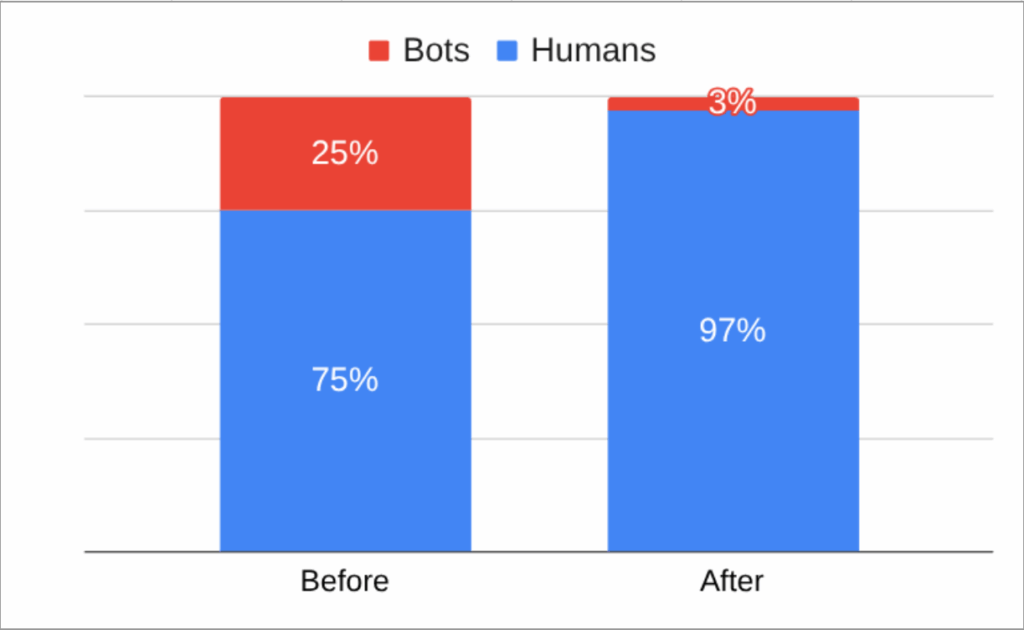Blog: How AI Optimization Mistakes Fuel Ad Fraud and Waste Paid Media Budgets
Key Takeaways
- What is the AI Bot Trap?
When optimizing for weak, cheap goals (e.g., Page Views), AI enters aNegative Feedback Loop and over-allocates budget to bots that fake performance metrics. - How Can You Stop Ad Fraud?
Break the loop by implementing the Guardrail Principle: switch to high-intent signals (e.g., Qualified Leads). This strategy forced one client's bot traffic to drop 88%. - Why Can't GA Detect Bots?
Traditional analytics tools (GA4, Adobe Analytics) only measure volume, not quality. You must use Independent Fraud Detection tools as a critical guardrail to ensure your bidding models train on clean, human-driven data.
Table of Contents
What Happens When You Optimize for the Wrong Goal?
AI is supposed to make paid media smarter. So why is it helping bots drain your budget?
AI-powered campaigns promise efficiency. Optimization. Scale. But when your algorithm is chasing the wrong signals, it doesn’t just miss the mark, it turns your budget into a buffet for bots.
What if your highly efficient AI is learning to love bots?
The problem of ad fraud is real. 20% to 30% of digital media spend is impacted by fraud.
It’s not only real, it’s getting worse. Global losses from sophisticated invalid traffic (SIVT) and ad fraud are projected to climb toward $172 billion by 2028 (up 51% from today), with bots making up a significant portion (42%!) of all internet traffic.
Malicious bots already make up a disturbing chunk of all internet traffic. And when your AI doesn’t know better, it learns to love that traffic, because bots are really good at faking what AI-led media tools are designed to go after, efficient performance.
The core lesson is this: AI is the future of advertising, but it only works with the right guardrails.
We recently tested this theory and found a fix that dropped a client’s bot traffic from 25% to 3% in a single channel. Here is our story and the three critical guardrails you need to implement today.
How We Dropped Bot Traffic 88%
A client came to us with robust engagement metrics on their Meta campaigns, but their down-funnel sales were stagnant. Their previous strategy optimized Meta primarily for a low-intent metric: Landing Page Views.
We used a dedicated bot-detection tool to audit their traffic quality. The result was staggering: nearly 25% of their Meta traffic was non-human (bots).
The AI was technically doing exactly what they asked. Bots are highly efficient at “viewing pages” and generating high time-on-site/low bounce rate signals. The algorithm found the fastest, cheapest way to deliver the specified outcome, and it happened to be bot traffic.
The Fix: Give AI a Harder Target
We swapped in a more meaningful (high-intent, friction-based) conversion goal: Lead-Form Submissions.
- The Results:
- Bot traffic dropped 88%
- Qualified leads increased 41%
- Spend became 41% more efficient
- The Lesson: AI isn’t the enemy. Misaligned goals are. When you set weak targets, you teach your AI to feed fraud. When you raise the bar, it chases the right traffic.

Why Are AI-Powered Campaigns Like Google PMax Vulnerable to Ad Fraud?
AI thrives on scale and pattern recognition. Fraudsters know this, and feed it. This problem is accelerating because modern automated systems, while efficient, create fertile ground for Sophisticated Invalid Traffic (SIVT).
What is Sophisticated Invalid Traffic (SIVT)?
SIVT refers to advanced, non-human traffic that mimics human behavior (scroll, dwell time, keystrokes) and is designed to evade standard platform bot filters.
Why PMax and Similar Platforms Are Easy Targets
Highly automated campaigns like Google’s Performance Max (PMax)and Meta’s Advantage+ are particularly vulnerable.
- The Risk:
- PMax and Advantage+ operates as black boxes with minimal user oversight
- Fraudsters exploit opaque inventory (like Google’s Search Partners or Meta’s Audience Network)
- The Negative Loop: The AI sees low-cost clicks from these placements convert (even if it’s a fake conversion) and, lacking visibility into the source quality, it drives more budget to the fraudulent source.

How Can You Stop AI From Optimizing Toward Bots?
To win with AI-driven media, you must stop optimizing for volume and start optimizing for quality. Here’s how to train your AI to prioritize real human behavior and stop wasting spend on fakes.
1. Set Bot-Resistant Conversion Goals
Avoid optimizing toward any goal that is trivial to automate. Make your AI work harder by choosing high-friction goals.

2. Implement Independent Fraud Detection
Platforms like Google Analytics and Adobe Analytics are designed to report traffic volume, not traffic quality. They cannot tell you if a visitor was a human or a bot.
- The Fix: Use a dedicated third-party anti-fraud tool. This allows you to filter the traffic before it pollutes your bidding models, ensuring your AI learns from a clean data set of only human behavior.
3. Harden Your Forms and Monitor Suspicious Activity
Bots are constantly testing and adapting. You need basic defensive layers:
- Form Security: Implement layers like reCAPTCHA v3 or honeypot fields on all lead forms.
- The Velocity Test: Watch for massive spikes in traffic from suspicious regions or times of day. If your form gets hit hard and fast, it’s probably a bot swarm.
How to Audit Your AI Campaigns for Fraud
Here’s a quick checklist:
- Are you optimizing for a real business outcome, not a vanity metric?
- Have you run a third-party traffic quality audit in the last 60 days?
- Are forms protected with bot filters?
- Are your campaigns seeing unexplained performance spikes?
- Are you tracking view-through conversions separately?
If you answered “no” to any of the above, it’s time to tighten up your campaigns.
Prevent Bots from Stealing Your Paid Media Budget
AI-driven media is powerful, but it is ultimately a mirror of the data you feed it. You can’t trust the results if you can’t trust the data. If you are not actively auditing your traffic quality, you are allowing bots to exploit your campaign logic and effectively taxing your budget.
Ready to stop paying the bot tax on your ad budget? It’s time to audit your traffic quality, build the right guardrails, and retrain your AI to chase real humans, not clever bots.
FAQs
What is ad fraud in AI-driven media campaigns?

Ad fraud happens when bots or fake traffic exploit weak optimization goals, draining budgets while pretending to deliver performance.
How do I stop bots from faking conversions?

Set harder conversion goals, implement fraud detection tools, and secure forms with CAPTCHA or honeypots.
What is a view-through conversion (VTC)?

VTCs occur when a user sees—but doesn’t click—an ad, then converts later. Bots exploit this by generating fake impressions and stealing credit.
Is Google Performance Max vulnerable to ad fraud?

Yes. Because of its automation and lack of placement transparency, it’s particularly vulnerable to bot-driven fraud and attribution theft.



